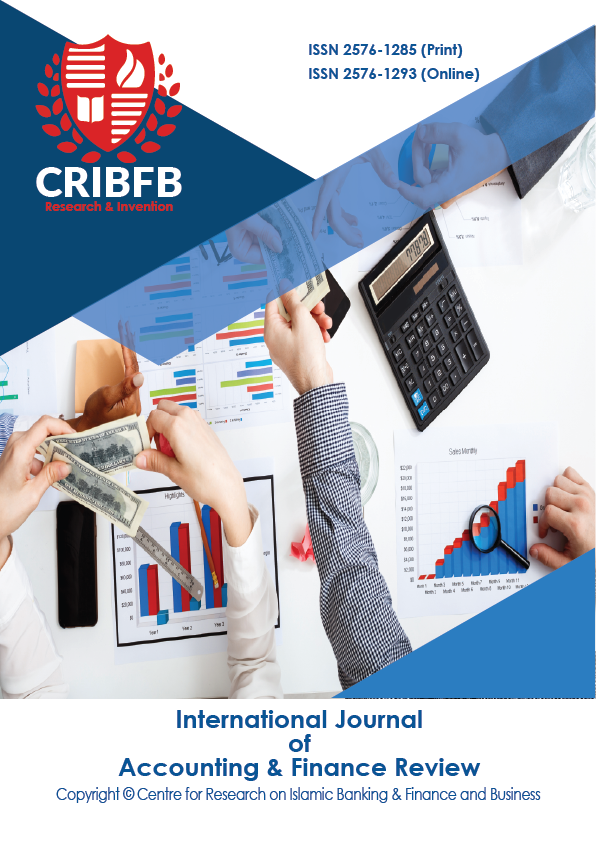ANALYST FORECAST DISPERSION, INVESTOR SENTIMENT, AND THE CROSS-SECTION OF STOCK RETURNS
Main Article Content
Abstract
This paper explores the role investor sentiment plays in the relationship between analyst forecast dispersion and stock returns. With short sale constraints, stock prices are determined by the optimistic investors. There are more optimistic investors during the high sentiment periods when investors suffer more from psychological bias. This is the first paper to document that following the high sentiment periods, stocks with the most analyst forecast dispersion are overpriced, earning significantly negative returns, while those with the least analyst forecast dispersion are not overpriced as the degree of belief dispersion is low. However, following the low sentiment periods, both are not overpriced. A portfolio that longs the least dispersed stocks and shorts the most dispersed stocks yields significantly positive returns only following the high sentiment periods. My findings can potentially reconcile the puzzling risk effect and mispricing effect in the literature. The risk (mispricing) effect suggests a positive (negative) relation between analyst forecast dispersion and future stock returns. Presumably, the magnitude of the mispricing effect depends on the proportion of irrational investors and their bias, which is positively related to investor sentiment. During the high sentiment period, the mispricing effect takes over, and the overall effect is negative. During the low sentiment period, the percentage of irrational investors is mediate, and the mispricing effect and the risk effect counter each other, leading to insignificant relation.
JEL Classification Codes: G12, G40, G41.
Downloads
Article Details
Section
How to Cite
References
Almazan, A., Brown, K. C., Carlson, M., & Chapman, D. A. (2004). Why constrain your mutual fund manager?. Journal of Financial Economics, 73(2), 289-321. https://doi.org/10.1016/j.jfineco.2003.05.007
Avramov, D., Chordia, T., Jostova, G., & Philipov, A. (2009). Dispersion in analysts’ earnings forecasts and credit rating. Journal of Financial Economics, 91(1), 83-101. https://doi.org/10.1016/j.jfineco.2008.02.005
Baker, M., & Wurgler, J. (2006). Investor sentiment and the cross‐section of stock returns. The journal of Finance, 61(4), 1645-1680. Retrieved from https://ideas.repec.org/p/nbr/nberwo/10449.html
Baker, M., & Wurgler, J. (2007). Investor sentiment in the stock market. Journal of economic perspectives, 21(2), 129-152. https://doi.org/10.1016/ 10.1257/jep.21.2.129
Banerjee, S. (2011). Learning from prices and the dispersion in beliefs. The Review of Financial Studies, 24(9), 3025-3068. https://doi.org/10.1093/rfs/hhr050
Boehme, R. D., Danielsen, B. R., & Sorescu, S. M. (2006). Short-sale constraints, differences of opinion, and overvaluation. Journal of Financial and Quantitative Analysis, 41(2), 455-487. https://doi.org/10.1017/S0022109000002143
Cen, L., Lu, H., & Yang, L. (2013). Investor sentiment, disagreement, and the breadth–return relationship. Management Science, 59(5), 1076-1091. https://doi.org/10.1287/mnsc.1120.1633
Chen, J., Hong, H., & Stein, J. C. (2002). Breadth of ownership and stock returns. Journal of financial Economics, 66(2-3), 171-205. https://doi.org/10.1016/S0304-405X(02)00223-4
Cremers, M., & Yan, H. (2016). Uncertainty and Valuations. Critical Finance Review, 5(1), 85-128. https://doi.org/ 10.1561/104.00000020
Diether, K. B., Malloy, C. J., & Scherbina, A. (2002). Differences of opinion and the cross section of stock returns. The Journal of Finance, 57(5), 2113-2141. https://doi.org/10.1111/0022-1082.00490
Güntay, L., & Hackbarth, D. (2010). Corporate bond credit spreads and forecast dispersion. Journal of Banking & Finance, 34(10), 2328-2345. https://doi.org/10.1016/j.jbankfin.2010.02.019
Hribar, P., & McInnis, J. (2012). Investor sentiment and analysts' earnings forecast errors. Management Science, 58(2), 293-307. https://doi.org/10.1287/mnsc.1110.1356
Líubosí, P. A. Ł., & Veronesi, P. (2003). Stock valuation and learning about profitability. The Journal of Finance, 58(5), 1749-1790. https://doi.org/10.1111/1540-6261.00587
Ma, G. (2011). Analyst forecast dispersion and aggregate stock returns. University of Texas at Dallas Working Paper.
Miller, E. M. (1977). Risk, uncertainty, and divergence of opinion. The Journal of finance, 32(4), 1151-1168. https://doi.org/10.2307/2326520
Mugenda, N. G., Olweny, T., & Wepukhulu, J. M. (2022). THE ROLE OF INVESTOR SENTIMENT ON PRICING EFFECT OF PROFITABILITY RISK FACTOR IN KENYA. International Journal of Accounting & Finance Review, 10(1), 1-16. https://doi.org/10.46281/ijafr.v10i1.1569
Nagel, S. (2005). Short sales, institutional investors and the cross-section of stock returns. Journal of financial economics, 78(2), 277-309. https://doi.org/10.1016/j.jfineco.2004.08.008
Qu, S., Starks, L., & Yan, H. (2003). Risk, dispersion of analyst forecasts and stock returns. University of Texas at Austin Working Paper, 1-33.
Shleifer, A., & Vishny, R. W. (1997). The limits of arbitrage. The Journal of finance, 52(1), 35-55. https://doi.org/10.1111/j.1540-6261.1997.tb03807.x
Stambaugh, R. F., Yu, J., & Yuan, Y. (2012). The short of it: Investor sentiment and anomalies. Journal of Financial Economics, 104(2), 288-302. https://doi.org/10.1016/j.jfineco.2011.12.001
Zhang, X. F. (2006). Information uncertainty and stock returns. The Journal of Finance, 61(1), 105-137. https://doi.org/10.1111/j.1540-6261.2006.00831.x




